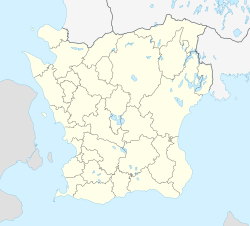Bäckaskog
Bäckaskog | |
|---|---|
 | |
| Coordinates: 56°03′N 14°20′E / 56.050°N 14.333°E | |
| Country | Sweden |
| Province | Skåne |
| County | Skåne County |
| Municipality | Kristianstad Municipality |
| Area | |
• Total | 0.38 km2 (0.15 sq mi) |
| Population (31 December 2010)[1] | |
• Total | 293 |
| • Density | 771/km2 (2,000/sq mi) |
| Time zone | UTC+1 (CET) |
| • Summer (DST) | UTC+2 (CEST) |
Bäckaskog is a locality situated in Kristianstad Municipality, Skåne County, Sweden, between Ivö Lake and Oppmanna Lake, with 293 inhabitants in 2010.[1]
The village has developed around the castle and the Premonstratensian monastery. The monastery was constructed in the early 14th century and after the destruction of the monastery in Vä, the monks from there were moved to Bäckaskog.
With the Danish Reformation, the monastery was turned into a castle and rewarded to Danish noblemen of the families Ulfstand, Brahe, Bille, Parsberg and eventually the Scanian family of Ramel. The castle was also owned by Swedish king Charles XV and crown-prince Fredrik of Denmark between 1885 and 1900. It was here in 1805 that a treaty was signed between England and Sweden, whereby Sweden joined the war against Napoleon.
Bäckaskog was connected to neighbouring towns of Sölvesborg and Kristianstad via the main road (now E22) and had a railway station, servicing also nearby castle of Trolle-Ljungby Castle, along the Sölvesborg-Kristianstad-Railroad.
Allegedly (Nordisk Familjebok) the name refers to the Swedish words for stream – bäck and forest – skog in that the place held them both.
References
- ^ a b c "Tätorternas landareal, folkmängd och invånare per km2 2005 och 2010" (in Swedish). Statistics Sweden. 14 December 2011. Archived from the original on 27 January 2012. Retrieved 10 January 2012.


